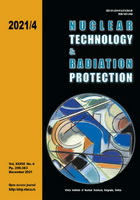
NEUTRONIC ANALYSIS OF AN ADS FUELLED WITH MINOR ACTINIDE AND DESIGNED FOR SPENT FUEL ENRICHMENT AND FISSILE FUEL PRODUCTION

Vol.
XXXVI, No. 4, Pp. 299-383
December 2021
UDC 621.039+614.876:504.06
ISSN 1451-3994
Pages: 299-314
Authors: Busra Durmaz, Gizem Bakir, Alper Bugra Arslan, and Huseyin YapiciAbstract
This paper presents analyses of enrichments of uranium taken out from Canada Deuterium Uranium and pressurized water reactors spent fuels and fissile fuel breeding from thorium in two different helium cooled-accelerator driven system designs, DESIGN A and DESIGN B. In the beginning, the 235U percentages in the uranium fuels taken out from the reactors spent fuels are 0.17 % and 0.91 %, respectively. Both system cores are fuelled with two different minor actinides compositions extracted from PWR-MOX spent fuels. The DESIGN A has one transmutation zone (enrichment zone) surrounding the fuel core and containing thorium or spent uranium fuels, while DESIGN B has a second transmutation zone (fissile fuel breeding zone) surrounding the first transmutation zone and containing only thorium fuel. In brief, a total of ten cases formed by the combinations of accelerator driven system designs, minor actinides components, and spent uranium with thorium fuels are analysed, which are six in DESIGN A containing one transmutation zone and four in DESIGN B containing two transmutation zones. Lead-bismuth eutectic alloy, a liquid heavy metal, consisting of 45 % lead and 55 % bismuth is used as target material in the investigated accelerator driven system. It is assumed that the target is bombarded with 1.2383·1017 protons per second and that the energy of each proton is 1000 MeV. This means a proton beam power of 20 MW. The 3-D and time-dependent neutronic analyses are conducted by using the MCNPX 2.7 and CINDER 90 nuclear code. Both accelerator driven system designs are operated until the values of keff rise to 0.985 to determine the longest operation times that are the effective burn times in all cases. Depending on the design, minor actinide composition, and fuel type (spent UO2 and ThO2), the results obtained at the end of cycle exhibit the effective burn times vary from 300 days to 2050 days, the fuel enrichments can reach up to 2.49-4.23 % and the values of gain reach up to 10.8-25.1.
Key words: accelerator-driven system, thermal reactor, spent fuel enrichment, thorium utilization
FULL PAPER IN PDF FORMAT (2.4 MB)